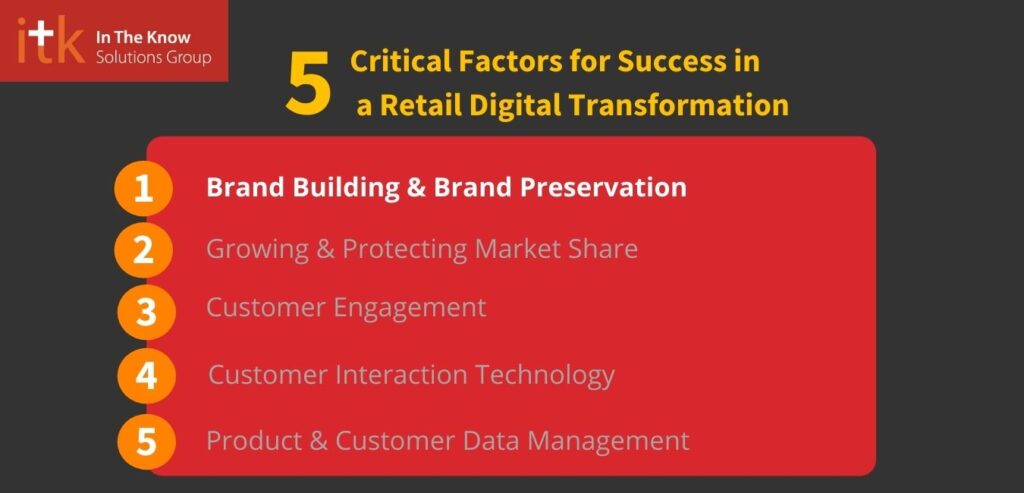Brand building is the process of establishing an identity for a product, a company or both. Brand identity is infused with qualities of intrinsic value. The most successful companies have imbued their products with characteristics like style, quality, consistency, safety, history, and lifestyle aspiration to name a few. People buy from brands they know and trust.
Brand Building and Brand Preservation is one of the core elements in any Retail Digital Transformation that also includes, Growing and Protecting Market Share, Customer Engagement, Customer Interaction Technology and Product and Customer Data Management.
While we all like to think of ourselves as rational consumers in fact our purchase behavior is governed by the dynamic between the quest for emotional satisfaction and product function. The most successful companies have understood this dynamic and invested in making an emotional connection with the consumer.
Nike Doesn’t Just Sell Apparel
Nike’s decades long dominance has exemplified the critical importance of establishing emotional resonance with consumers. Nike effectively imbues their products with attributes like perseverance, excellence, and a winning attitude through their close association with athletes who demonstrate these qualities. Nike took these same qualities of excellence and perseverance and moved them into everyday life creating whole new categories of products. They changed the entire perception of clothing from a single function to a lifestyle aspiration. They made the market what they wanted it to be and enjoyed decades of success as the preeminent sports apparel brand in the world. The “Just Do It” slogan inspired action beyond sports and wearing Nike apparel became a tangible demonstration of the consumer’s attachment to this sentiment as a lifestyle exhortation.
They were successful with this approach for many years but began to rest on their laurels. The “Just Do It” campaign became stale. This staleness was a classic example of cultural inertia. Cultural inertia reflects a natural desire to preserve what has worked in the past and not to take risk. Brand preservation does not mean letting the brand become ossified. Brand preservation is about keeping the aspirational and emotional connections with consumers throughout society’s evolutions. Ironically, to preserve the brand companies must constantly reconnect with consumers and reenergize the appreciation of what the brand means to them.
Nike was slow to do this and as a result created the market opportunity for Under Armour (UA) to exploit. UA leveraging voluminous amounts of market data quickly saw an opportunity to become the brand of a new, and younger generation of consumers. The results was that Nike came to be perceived as the establishment brand of older consumers. UA sponsored a new segment of X-treme sports activities called the X games, which appealed to the outlaw rebelliousness of young people. In so doing they created and legitimized a whole new industry segment that celebrated the new generation of extreme athletes. This was a risky investment that could have gone either way. What gave UA the confidence to pursue this initiative was the market knowledge research of the success that Nike established by connecting consumers with athletic excellence.
Nike Takes a Stand Most Companies Would Avoid
Nike responded in an extraordinary and innovative way. They believed that consumers wanted the same association with sports success to be applied to larger issues that affected them. By continuing a full-throated support of a particular endorsement, they waded directly into a controversy that most companies would have actively avoided. This statement cut right through societal lines. Nike took a public stand even in the face of being called out by the most powerful political office in the land. They did not waiver. What they did was to capitalize on the success of the “Just Do It” slogan and transformed it into “Just Do It Right” as it related to iconic American Values like justice and freedom. This move reenergized consumers and reestablished Nike’s position as not only the preeminent sports brand but the brand that sees the value of issues far beyond the playing field.
Consumer product companies cannot afford to have a myopic view of themselves considering only their products. They must consider how they are perceived by consumers. Consumers think about more than features and the aspirational aspects of products, they are looking for a connection to establish trust and loyalty. Once companies have earned the trust of consumers, they will enjoy a lifetime of value so long as they continue to honor it.
The most successful consumer brands invest in establishing an umbrella effect for all the products they make. The performance features of each product are imbued with the values of the corporate brand. Companies must recognize that there is a whole set of intangibles surrounding the corporation itself that must be developed and nurtured not just by pushing marketing information out but by listening to their customers via social media channels. By doing so it preserves the marketing umbrella effect not only serving as a catalyst for product extension and market entry but helps insulate any individual product in a time of difficulty.
J&J Turns Crisis into Trust Building Exercise
J&J Builds Trust A great example of this is Johnson & Johnson (J&J). J&J has sustained a decades long reputation with consumers for quality, safety, caring and value. Babies become J&J consumers from infancy and the relationship persists throughout their lives. From baby oil to pain relievers to “Band Aides” J&J is known around the world as brand that can be trusted. Their reputation has been critical in helping them navigate through business crisis. In 1982 an individual sabotaged packages of Tylenol on the shelf of a pharmacy in Chicago. This terrified the nation and caused panic regarding all pain relievers but particularly the Tylenol brand. Analysts predicted the end of the product line completely. J&J immediately responded with changes to their packaging and set the safety standard for the rest of the industry for what we now know and “Safety Packaging”. This action on their behalf of consumers was perceived as a genuine and effective response. J&J was rewarded with continued trust & loyalty by consumers as a result. Tylenol exists as a testament to this and continues to this day as a popular brand.
The history and trajectory of private brands mirror the same constraints and challenges as the nationally known brands. When first introduced, generic products were viewed with some suspicion and languished on store shelves. When repackaged and promoted as a store brand, they then inherited the attributes and value of the store’s umbrella brand identity. Customers shopping for flour would walk past a product labeled only as “Flour” but would purchase the identical product labeled as “365 Brand” at Whole Foods without hesitation. The reason for this is branding immediately conveys the quality and safety of the products that Whole Foods stands for. The same is true for the Kirkland brand at Costco, Archer Farms at Target and many others. Even a store brand can be a successful brand.
Conclusion:
Branding is a declaration of identity. This might be a statement of value. It may be a statement of quality. It may be a statement of style or combination of all or more. The success of branding is determined by how the brand message is communicated and if the communication is accurate and consistent. What a brand is not, is static. Brand preservation does not imply stasis. It is not an event but rather a continuous and ongoing exercise that seeks to create consumer interest and engagement either physical or virtual.
It is incumbent upon retailers to continue the conversation with consumers through brand extensions. This is done by adding related products under the brand umbrella. Retailers must recognize that the act of growing products under the umbrella, in fact changes the umbrella. The challenge is to remind consumers of the consistency of the brand while communicating that the brand is changing. Savvy brands embrace this challenge in order to make sure that their products continue to meet consumer need for emotional connection.
What’s Next?
To succeed in this changing landscape, store-native retailers will need to abandon their legacy hubris and start acting like their digital-native competitors. For a comprehensive view of the current state of retail and tips on succeeding in this new environment, download our latest whitepaper, “Retail Transformation Imperatives: 5 Imperatives for Retailers, Wholesalers and Brands.” A how to manual for navigating the ever-evolving retail world, and a blueprint for success in the new era of commerce.






